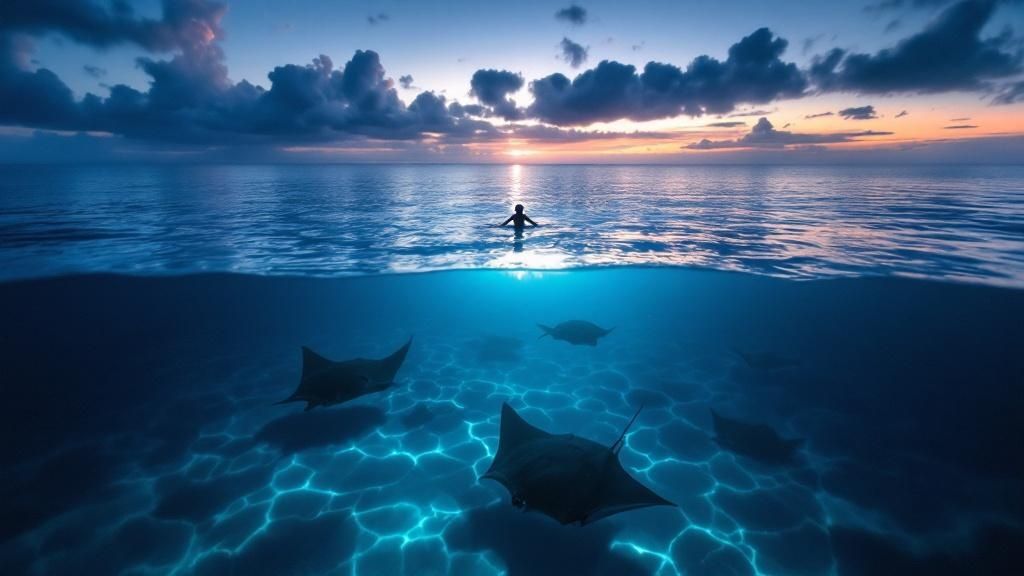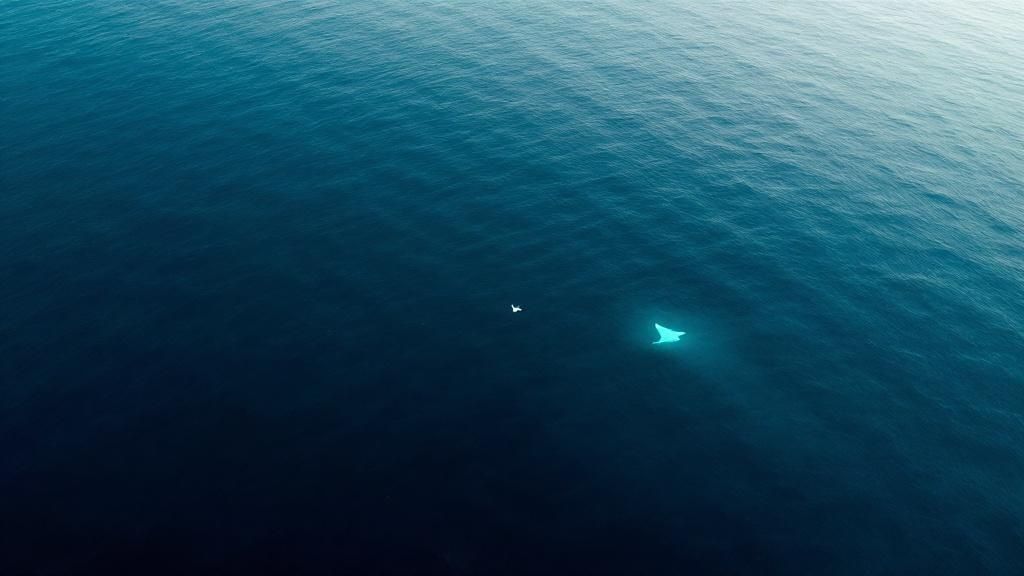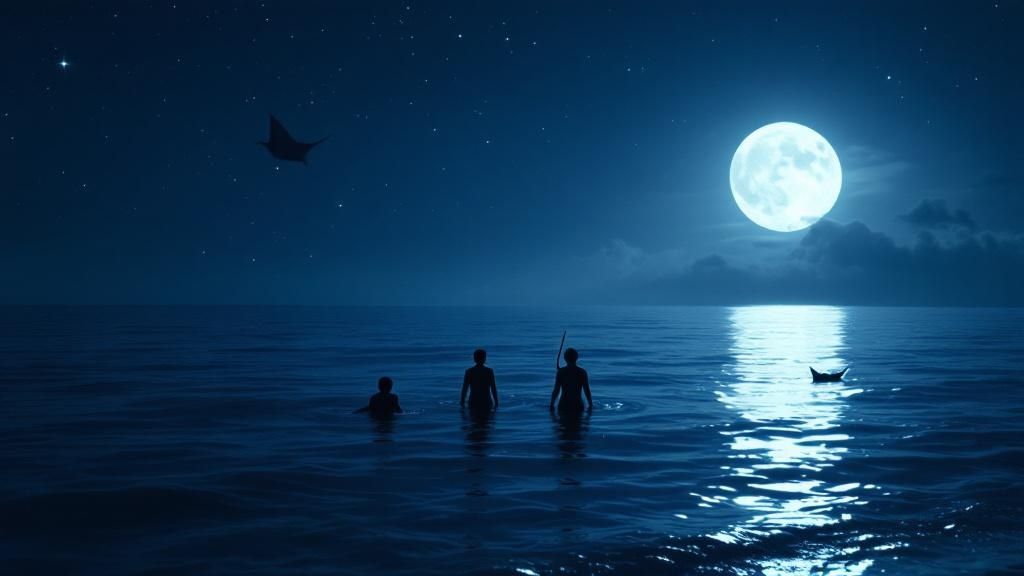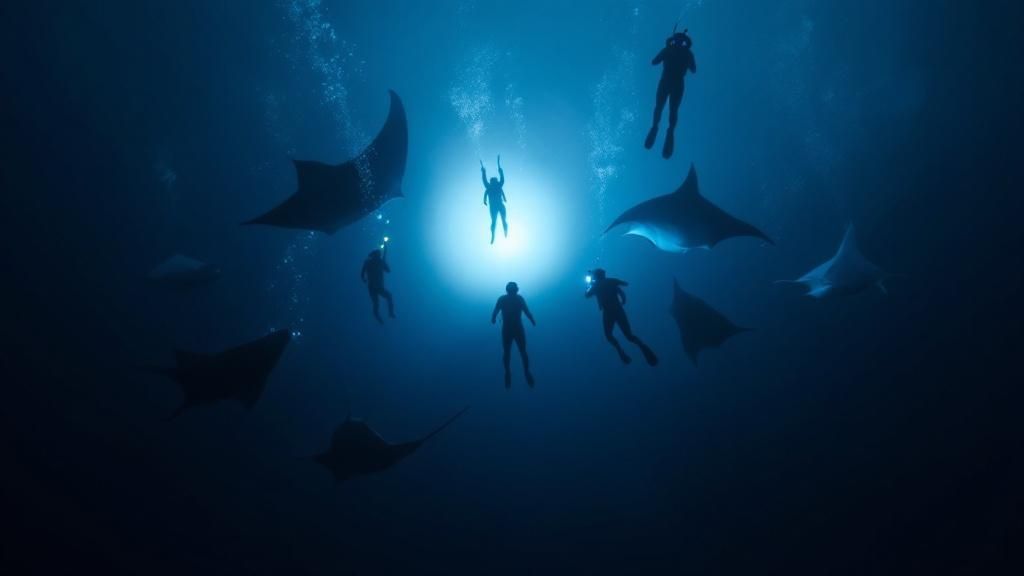Manta Ray Snorkel Big Island: Ultimate Guide & Tips
- Byron
- Jun 29
- 12 min read
Picture this: you're floating in the warm, dark Pacific waters just off the Kona coast. The only light is a soft glow from a custom-built board you’re holding, illuminating the water below like a gentle beacon. Then, out of the darkness, a massive, graceful shadow emerges. It’s a creature with a wingspan wider than a car, gliding just inches beneath you.
This isn't a scene from a nature documentary. It’s the very real, unforgettable magic of the manta ray night snorkel on the Big Island.
Your Guide to an Unforgettable Night Snorkel
This experience is world-famous for a reason. You get a front-row seat to watch majestic manta rays as they feed on plankton, performing an incredible underwater ballet of barrel rolls and swoops. It's truly awe-inspiring, completely safe, and easily one of the most memorable things you can do in all of Hawaii.

Your adventure typically starts with a boat ride that’s perfectly timed to catch a stunning Hawaiian sunset. On the way out, the crew will give you the rundown on manta ray behavior, safety procedures, and what to expect, making sure everyone feels confident before getting in the water.
Once you arrive at the snorkel site, you’ll slip into the ocean and hold onto the floating light board. From there, you just wait for the show to begin.
Why Kona Is the Global Manta Hotspot
There's a good reason this adventure is so tied to Kona. The unique geography of the coastline creates the perfect conditions for a reliable plankton supply, which in turn makes it the best place on the planet for consistent manta ray sightings.
We’re talking about a staggering 80-90% success rate at key sites like Manta Village and Manta Heaven. This incredible reliability has made the tour a major draw, attracting around 80,000 visitors a year. You can dig into more of these fascinating stats over at Manta Ray Advocates Hawaii.
This isn't just another tour; it's a chance to witness a predictable, completely natural feeding event. The mantas aren't baited or trained. They just show up for their nightly meal, and you get to watch.
To give you a clearer picture of what to expect from this once-in-a-lifetime adventure, here's a quick overview of the key details.
Big Island Manta Ray Snorkel at a Glance
This table breaks down the essential details you need to know about the Kona manta ray snorkeling experience.
Aspect | Details |
|---|---|
Activity Type | Guided night snorkel in the open ocean |
Duration | Typically 1.5 to 2.5 hours total, with about 30-45 minutes in the water |
Location | Primarily off the Kona Coast at sites like Keauhou Bay (Manta Village) or Garden Eel Cove (Manta Heaven) |
What You'll See | Reef manta rays feeding on plankton attracted by underwater lights |
Gear Provided | Wetsuit, snorkel, mask, and a floating light board for stability and viewing |
Swimming Skill | No expert swimming skills needed; you just need to be comfortable floating with gear |
Best Time of Year | Year-round, as manta rays are non-migratory residents of the Kona coast |
Essentially, as long as you're comfortable floating in the water with a snorkel and mask, you’re ready for this incredible encounter.
Choosing the Right Manta Ray Tour in Kona

With dozens of boats heading out from Kona's harbors every single night, trying to pick the right manta ray snorkel on the Big Island can feel a bit like swimming in circles. Don't worry, it's simpler than it looks. Your decision really boils down to just a handful of things that will shape your entire night, from the boat ride itself to your actual time in the water with the mantas.
The first big choice you'll make is about the boat. Operators run everything from big, stable catamarans to small, zippy rafts, and each offers a totally different vibe.
Large Catamarans: These are your go-to for comfort. If you have kids or are worried about getting seasick, the smooth ride and extra space on a catamaran are a lifesaver. Most of these bigger boats leave from Keauhou Bay, which means a super short trip to the Manta Village site.
Small Rafts or Zodiacs: Looking for a thrill? This is it. These boats give you a faster, more adventurous ride that can be pretty bumpy but a ton of fun. They usually leave from Honokohau Harbor and get you to the site quickly, often with a smaller, more intimate group.
Boat Size and Where You Leave From
Believe it or not, the departure harbor is a huge deal. If you book a tour out of Keauhou Bay, you're looking at a quick five-minute boat ride to Manta Village. That's it. On the other hand, boats leaving from Honokohau Harbor have a 30 to 45-minute journey to get to Manta Heaven. If seasickness is even a remote possibility for you, that shorter ride from Keauhou is a game-changer.
Group size is another thing to think about. Big boats mean more people, which can make the water feel a little crowded. Smaller rafts offer a cozier trip, and you’ll likely get more one-on-one time with your guide. It's always a good idea to ask about their guide-to-guest ratio—the lower, the better.
No matter which tour you choose, the goal is the same: to float on the surface and watch the manta rays' incredible nightly feeding ballet. The boats shine powerful lights into the water, which attracts plankton, and the mantas show up for the buffet. You'll be watching reef manta rays (Mobula alfredi), which can have a mind-blowing wingspan of around 14 feet!
Sunset or After Dark?
You'll also need to decide between a sunset tour and a later "after-dark" trip. The sunset tours are amazing because you get a two-for-one deal: a gorgeous Hawaiian sunset on the water followed by the manta experience. The later tours can sometimes be a little less crowded and have their own unique magic, floating under a sky packed with stars.
At the end of the day, there’s no single "best" tour—just the one that’s best for you. Figure out what's most important: comfort, a shot of adrenaline, group size, or pure convenience. Once you weigh those factors, you’ll be able to confidently book the manta ray snorkel big island trip that fits you perfectly.
For a deeper dive into the different locations, check out our guide on the top snorkeling spots for seeing manta rays on the Big Island to get even more insider info.
How to Prepare for Your Manta Ray Snorkel Adventure

A little prep work can make the difference between a good trip and an unforgettable one. Taking care of a few small details before you even leave for the harbor means you can relax and soak in the experience, rather than worrying about being cold or queasy.
Think of it as your pre-flight checklist. The goal is to show up to the boat feeling warm, comfortable, and ready for the main event.
One of the most important things to do actually happens a couple of hours before your tour: eat a light meal. An empty stomach can make seasickness worse, but you also don't want a heavy, greasy meal sloshing around. Something light an hour or two before you set off is the perfect sweet spot.
What to Bring (And What to Leave at the Hotel)
The good news is you don’t need to pack much. Your tour operator will have all the essential gear covered—wetsuits, masks, snorkels, the works. Your main job is to think about your own comfort before and after you hit the water.
Here’s a quick list of what you should definitely have with you:
A Towel and Dry Clothes: This is an absolute must. The boat ride back to shore can get surprisingly chilly once the sun goes down and you're wet. Having a dry shirt or a hoodie to throw on makes a huge difference.
Reusable Water Bottle: Staying hydrated is key, even on a short trip. Most boats have water, but it's always easier to have your own.
Seasickness Medication (If you need it): This is a big one. If you even think you might get seasick, take your preferred remedy before you get on the boat. Once you start feeling woozy, it’s often too late.
Just as important is what you don’t bring. Please leave any traditional sunscreen behind. The chemicals in most common sunscreens, like oxybenzone and octinoxate, are extremely damaging to Hawaii's fragile coral reefs. If you have a late afternoon tour where the sun is still a factor, be sure to use only reef-safe sunscreen.
Pro Tip: I always wear a rash guard or a thin, long-sleeved athletic shirt under my wetsuit. It adds a welcome layer of warmth in the cooler night water and, as a bonus, makes getting the wetsuit on and off so much easier.
Protecting the Mantas and Their Home
How you prepare has a direct impact on the very creatures you're coming to see. By making conscious choices, like using reef-safe products, you’re doing your part to protect this incredible marine ecosystem.
Every single person who gets in the water plays a role in keeping this experience pristine for generations to come. Following these simple tips helps ensure the Kona manta rays will continue to thrive, turning your tour from just a cool activity into a truly responsible wildlife encounter.
What to Expect During Your Manta Encounter

This is the part of the manta ray snorkel Big Island experience that gets your heart pounding. It all starts with a boat ride, cutting across the Pacific as a brilliant Kona sunset melts into the horizon. There's a real buzz of excitement in the air as you head out to the site.
On the way, your guides will fill you in on everything you need to know. They’ll share some amazing facts about the local manta rays and, most importantly, explain how to interact with them safely. The goal is to make sure you feel totally comfortable and prepared for what’s ahead.
Once you arrive, the crew gets to work setting up a large, floating light board. This isn't just any old light; it's a powerful, custom-built platform that acts as your front-row seat. When they switch it on, the bright beams cut through the dark water, attracting tiny plankton—the mantas' favorite meal. You'll then slide into the ocean, which is usually surprisingly warm, and find a spot to hold onto the board.
The Awe-Inspiring Underwater Ballet
Floating there in the dark, you’ll hear nothing but the gentle slap of water against the boat. For a few minutes, it’s just you and the ocean. Then, you see it. A shadow emerges from the darkness, growing bigger and more distinct as it nears the light.
Your first manta ray appears. It's a surreal, breathtaking moment. These gentle giants glide effortlessly toward the plankton, sometimes passing just inches from your mask. It feels like you’ve been invited into their world. They perform a silent, graceful dance, swooping and doing barrel rolls to scoop up their food. It’s incredibly peaceful and deeply moving.
The most important thing to remember is that you're a guest in their dining room. The whole encounter is based on passive observation. That means no touching, no chasing, and staying with the light board. Your job is simply to float, watch, and be amazed.
This isn’t just a rule for your safety; it’s crucial for protecting the mantas. Their skin has a delicate mucus coating that can be damaged by a human touch, making them susceptible to infections. By holding onto the raft and keeping your fins still, you help ensure this amazing experience can continue for years to come. You can read more about what makes this so special in our article on why the manta ray night snorkel is the ultimate Kona adventure.
Setting Realistic Expectations
While manta sightings are extremely common, it's good to remember these are wild animals in their natural habitat. Some nights, you might see just one or two. On other nights, a dozen or more might join the party!
Here’s a quick rundown of what to expect:
Time in the Water: You’ll typically be snorkeling for about 30 to 45 minutes.
What You’ll Be Doing: Holding onto the light board and watching the show.
The Vibe: This is a calm, awe-inspiring experience, not a high-octane thrill ride.
Go into it with an open mind and a respectful attitude. If you do, you’re practically guaranteed a night you’ll never forget.
Your Camera and the Manta Rays: A Guide to Ethical Photos
You're definitely going to want photos. Who wouldn't? Seeing these giants glide through the water is a memory you'll want to keep forever. But getting a great shot in the dark, underwater, is a unique challenge. More importantly, it has to be done without harming the mantas.
Most people bring an action camera, something like a GoPro. The single most important thing you can do is set it to its "low light" or "night mode" before you even get on the boat. This tells the camera to make the most of the ambient light from the big "campfire" your guides set up on the seafloor, which will give you much clearer, less grainy video.
Now for the cardinal rule of manta photography: absolutely no camera flash. Ever. A sudden, blinding flash is incredibly disruptive to the mantas. It can startle them, mess with their vision, and even drive them away from their dinner. Your guide will be very clear about this—it’s a non-negotiable rule for their safety.
How to Be a Manta Advocate
From the moment you book your tour, you have the chance to be a "Manta Advocate." It's about more than just what you do in the water; it's about making choices that protect Kona's amazing resident manta population for the long run.
It all starts with picking the right tour company. Look for operators who are vocal about their commitment to sustainability. Do they talk about small group sizes? Do they provide a thorough pre-snorkel briefing on how to interact safely with the mantas? These are the companies that see the bigger picture—they're invested in keeping this ecosystem healthy, not just cashing in on a quick tourist attraction.
The most important rule of the entire experience is simple: Do not touch the manta rays. Their skin is covered in a delicate mucus layer, which is their first line of defense against nasty bacteria and infections. Touching a manta, even by accident, can rub off this protective coating and make them sick.
Your Actions Matter More Than You Think
Every snorkeler's behavior adds up. When you follow the guidelines, you're actively contributing to the health and safety of these incredible animals. You're helping make sure this experience can continue for years to come.
It really boils down to a few core principles for ethical manta viewing:
Be a passive observer. Your job is to hold onto the light board and just float. Let the mantas do their thing. There's no need to kick or swim after them—that just spooks them and makes them waste precious energy.
Stay on the surface. Snorkelers should remain flat on the surface of the water. Diving down, even a few feet, can get in the way of their feeding paths and disrupt the whole show.
Let them lead the dance. The mantas are in control. If one glides right up to you (and they often do!), just stay calm and still. They are incredibly graceful and will swerve around you at the last second. It's all part of the magic.
By following these simple rules, you're doing your part to preserve one of the world's greatest natural wonders. Your responsible choices ensure the manta ray snorkel on the Big Island remains a shining example of how wildlife tourism should be done.
Answering Your Top Questions About Manta Ray Snorkeling
Even after seeing amazing photos and videos, it's completely normal to have a few questions before you book a manta ray snorkel big island tour. It's a unique adventure, after all!
Let's walk through some of the most common things people ask. My goal is to clear up any uncertainties so you can book your spot feeling excited and confident.
What if I'm not a strong swimmer?
This is probably the number one question we get, and the answer puts most people at ease: you don't need to be a strong swimmer. At all.
The entire time you're in the water, you'll be holding onto a large, custom-made floatation board. Think of it as a big, stable surfboard with handles and bright lights underneath. You just float, hold on, and put your face in the water. Your wetsuit provides buoyancy, and the board provides all the support you need.
If you're comfortable floating in a pool with a mask on, you have all the swimming skills required.
When Is the Best Time of Year to Go?
Here's the great news—there's no "bad" time to go! This is a fantastic year-round activity.
The reef manta rays here off the Kona coast don't migrate. They live here permanently because their primary food source, plankton, is present all year long. This consistency leads to an incredible sighting success rate, often over 85-90%, whether you come in the summer or winter.
Your biggest decision will be based on your own vacation schedule, not the mantas' schedule.
Keep in mind that manta rays are wild animals, so a sighting can never be 100% guaranteed. But the best tour operators have policies for those rare "no-show" nights, which speaks volumes about their confidence.
What Happens if We Don't See Any Manta Rays?
It's a fair question, but don't worry, the tour companies have a plan for this. Most reputable operators offer what's called a "manta guarantee."
If for some reason the mantas decide not to show up on your tour, you can come back and try again on another night for free. It's usually on a standby basis, but it's a great safety net.
This is a huge reason why I always tell people to book their manta ray snorkel big island adventure for one of their first nights on the island. That way, you have plenty of time to take advantage of the guarantee if you happen to be on one of those very rare, unlucky tours.
Want to dive even deeper into what the night will be like? Take a look at our complete guide to manta ray encounters for a full play-by-play.
Ready to witness the magic for yourself? At Manta Ray Night Snorkel Hawaii, our experienced guides and small group sizes ensure an intimate and unforgettable adventure. Book your tour today and prepare for the memory of a lifetime.
Comments